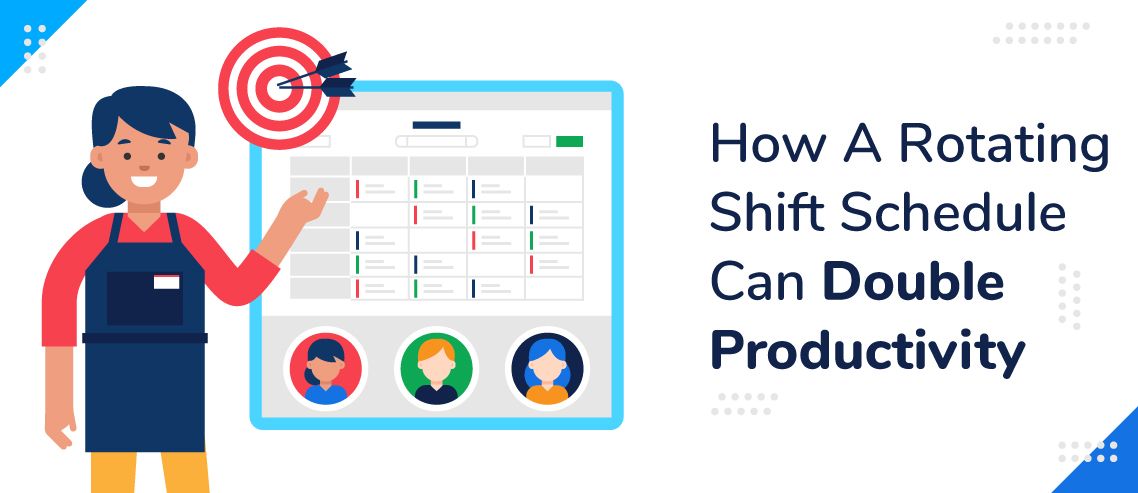How A Rotating Shift Schedule Can Double Productivity

If your doors are open sixteen, eighteen, or even twenty-four hours a day, then you probably struggle from time to time with your staff scheduling.
Finding workers willing to work late-night hours for extended periods of time is a constant battle. People want to be at home with their families. They want a consistent sleep schedule and some semblance of social life.
How do you keep your output high and keep your staff happy and engaged simultaneously?
Rotating shifts are the solution.
This set-up allows everyone to take turns working early, mid-day, and late shifts.
What is a Rotating Schedule?
A rotating shift is a pattern of work schedule that suggests that shifts change according to a predetermined rotating schedule. It’s usually used by the types of businesses that need to be extended or 24/7 coverage.
The shift pattern can be continuous (24/7) or semi-continuous (running at 2 or 3 shifts per day). An example of this might be that an employee works two day shifts and then two night shifts.
Who Uses Rotating Shifts?
Businesses that need more coverage than an average 9-5 company will often rely on rotating shifts to ensure there’s enough coverage throughout the business hours. These might be businesses that operate 24 hours a day, 7 days a week, or companies that start early in the morning and close late in the evening:
- Defense contractors and military personnel
- Hospitality management such as hotel concierge or service staff
- Transportation services such as bus drivers and rental car services
- Utility providers such as utility workers
- First responders such as 911 operators, police, and firefighters
- Manufacturing such as production managers and factory workers
- Retail such as store associations, department managers, and gas station attendants
- Restaurants with 24-hour service or late night service
Some of these industries will need staff coverage around the clock, while others may operate for extended hours, requiring more coverage than a daytime-only business.
How a Rotating Shift Schedule Works
Rotating shifts work on a weekly or monthly basis, whereby there are several set shifts that different employees work over the course of that week or month.
Shifts are usually distributed evenly so that there’s a fair allocation of “harder” shifts and easier ones.
For example, night shifts will be distributed evenly across the team, so that one person isn’t given more than others. Employees are usually given a variety of shifts, with a sensible allocation of days off. For example, an employee might walk three night shifts followed by two days off and then two day shifts.
Clearly, the way in which businesses manage their shift schedules will depend on the industry, the nature of the role, and the hours of business operation.
How to Schedule Employees for Rotating Shifts
The way you’ll schedule your employees for rotating shifts will depend entirely on your business: your industry, your number of employees, your company work hours, and your working culture. You may also have personal preferences for yourself and your employees. Do you want your teams to have some control over their shift schedules? All this can be come effecently using modern employee scheduling app designed for hourly employees.
You can now start scheduling your employees. Start by breaking up your day/night into shifts and look at how much coverage you’ll need for each shift. You can then create different teams to ensure that you have enough coverage on each of your shifts. This way, you can ensure that the same team members will be working together, creating continuity and stability among your employees.
Finally, determine the type of rotating shift pattern you want to use:
- Frequent: e.g. an employee goes from working day shifts to night shifts within a week.
- Slow: Shift changes happen over the course of several months.
- Weekend: Employees take turns working weekend shifts.
- Partial: some staff will work fixed shifts while others will be on a rotating schedule.
Rotating shifts keep things fresh. Working the night shift from time to time eradicates your commute, gives you a chance to experience a slower shift and gives you an opportunity to work with different people. The day shift gives you a normal sleep schedule and more time with your friends and family.
Here are some benefits and best practices for implementing a rotating shift schedule. Without any further ado, let’s dive deep and find out how you streamline your shift rotation:
Benefits of Implementing A Rotating Shift Schedule
1. Evenly Distributes Talent & Expertise
An often overlooked benefit to rotating shifts is the ability to spread your high performers amongst all shift variations.
Someone with special skills may be in high demand for various projects, and having them periodically rotate into different shifts can prevent unnecessarily hiring subject matter experts you don’t need.
Plus, service-based businesses get a chance to ensure their customers have a great experience no matter what time of day.
2. Improve Morale, Cohesiveness, and Collaboration
A lot of companies operate with multiple shifts running around the clock. Here’s a common shift schedule example:
- Day shift: 8 AM to 5 PM
- Night Shift: 4 PM to 1 AM
- Graveyard Shift: 12 AM to 9 AM
Manufacturing and construction companies are common examples here. Ensure you’re up to date with all the top construction management software on the market with our in-depth blog post.
Naturally, the night shift and the graveyard shift are the least popular. Having one subset of employees take the less desirable shifts can create a divide at work. One that can lower morale, lower productivity, and even generate animosity between shifts.
With a rotating shift schedule, every employee takes turns taking on a less desirable shift, which has the opposite effect.
Happy workers are more productive. That’s a fact.
Therefore, investing in a structure that boosts morale – or at the very least evenly distributes the pain – is going to pay off in the long run. Working different shift times also means that employees get to interact with a broader mix of people ranging from customers, suppliers, vendors, associates, and other business partners.
Some rotating shifts can compose 12-hour cycles with additional days off. They sound more daunting, but in reality, they offer greater flexibility and longer stretches of days off. Police officers and nurses are common examples here.
3. Increase Operational Efficiency
Arguably the greatest benefit of rotating shifts is to the company itself. Sure, rotating shifts boost morale and keep things on an even keel, but the biggest benefit is having employees working around the clock.
With rotating shifts, you get to keep all hours covered while still providing ample time off. There’s also a reduction or downright elimination of production disruptions that occur with shift changes. This is especially true if you overlap shifts by one hour, so there’s a natural transition.
Safety and risk mitigation is also bonus factor with rotating shifts. With a balanced schedule, you’ll see fewer errors and accidents. Restaurant and service jobs also benefit because everyone gets an opportunity to earn more during peak hours. People can also train during non-peak times, which will improve your staff’s productivity and effectiveness.
Rotating Shift Best Practices
No matter the industry, creating a successful rotating shift schedule boils down to a few best practices:
- Consistent start and end times for same-week shifts
- Sufficient time between shifts to accommodate a full sleep cycle
- Shift swapping opportunities and flexible arrangements
- Scheduling with plenty of advanced notice
- Over-communication of scheduling and shift changes
Careers that involve late-night shift work are challenging. There are health concerns, social implications, and productivity often suffers. Yet, late shifts are just the nature of some industries and professions. We simply need certain people working around the clock to keep us safe and keep our economy moving.
On the bright side, good leaders can implement rotating shifts that will alleviate a lot of the heartache that comes with late-night shift work. When they’re built with care and empathy, neither the employee nor the business suffers.
Save Time and Money — Implement a Rotating Shift Software
Use an all-in-one platform like ZoomShift for employee scheduling to boost transparency and make it easier to process shift changes. ZoomShift keeps your staff accountable by keeping the schedule, shift preferences, and communication all in one place.
It also makes it incredibly easy to create shift schedules weeks or months in advance. Thanks to the built-in shift template feature. Empower your team to swap shifts if the rotating schedule doesn’t suit. Notify your team of open shifts when you need extra help.
Building employee schedules can be chaotic. Things can slip through the cracks – employee time tracking, staff availability preferences, time off requests, and last-minute call-ins.
ZoomShift’s employee scheduling software keeps it all in one place.
- View availability, time offs, shift swaps, and events from one place.
- Create schedules by day, week, and month.
- Copy schedules weekly and apply-templates.
- Manage paid time off
- Export employee timesheet in one click
How ZoomShift Employee Scheduling Works
Try your hand at building a rotating shift in ZoomShift. It’ll take less time than you think, and it could double or triple your productivity while simultaneously boosting employee morale. It’s truly a win-win!
Other Common Types Of Rotating Shift Schedule
Here are five types of rotating shift schedules:
1. DuPont Shift Schedule
This rotating shift schedule uses four teams, each working 12-hour shifts to give your business 24/7 coverage. A typical four-week cycle for a team working under DuPont rotating schedule would look something like this:
- Work four nights
- Rest three days
- Work three days
- Rest one day
- Work three nights
- Rest three days
- Work four days
- Rest seven days
One major benefit of this working schedule is that it provides one of the longest breaks between working days. This allows your employees to rest well and recharge.
2. 24/48 Shift Schedule
This schedule works on a three-day cycle and requires three teams for it. Each team works for 24 hours, followed by two days off. This way every employee ends up working almost 56 hours per week.
3. Pitman Shift Schedule
The Pitman shift schedule is similar to DuPont but differs slightly in structure. It comprises four teams and two 12-hour shifts, but the sequence of working days and days off differs. Here’s what a 2-week for four teams looks like under Pitman schedule:
- Team 1: DDOODDD-OODDOOO
- Team 2: NNOONNN-OONNOOO
- Team 3: OODDOOO-NNOONNN
- Team 4: OONNOOO-DDOODDD
4. 4-3 Shift Schedule
The 4-3 shift schedule divides employees into six groups. Each group rotates across three different 8-hour shifts.
A typical cycle for an employee on this schedule would include four consecutive days working the early shift from 6 am to 2 pm, followed by a rest period of three days.
Subsequently, they transition to four midday shifts from 2 pm to 10 pm, take another three days off, and then move to four night shifts from 10 pm to 6 am, capped by a final stretch of three rest days.
5. 2-2-3-2-2-3 Shift Schedule
The 2-2-3-2-2-3 uses 12-hour shifts and operates on a recurring four-week cycle. Each of the four teams works a pattern of two day shifts, followed by two days off, three day shifts, followed by two days off, two day shifts, then three days off.
The pattern then repeats with night shifts. With this rotation, a team member works almost 42 hours each per week.
Bonus: 10 Top tips for rotating shift management for managers
1. Provide your staff with training and support services to help them adjust to rotating shifts, especially if you require night shifts.
2. As far as possible, allow your employees to register their shift preferences and try to accommodate them.
3. Give your employees as much notice as possible about their shift pattern.
4. If you can, allow your employees to request shift swaps and facilitate this process.
5. Provide easy access to their shift schedules.
6. Notify staff of any changes clearly and multiple times.
7. Monitor your employee’s hours to ensure there are enough rest days and that their schedule isn’t too demanding.
8. Rotate shifts from day into the evening rather than an evening to day to allow for better adjustment.
9. Enforce strict shift start and end times so that shifts don’t overrun.
10. Adopt employee scheduling software like ZoomShift to enable clear communication, transparency of shift schedules, facilitated time-off and shift-swap requests, and avoid human error.
Key Takeaways
Rotating shift schedules aren’t for every business, but are beneficial to businesses that require extended or around-the-clock cover.
The key to getting rotating shifts right is to find a tool like ZoomShift that helps you keep lines of communication open, allow as much control with your teams as possible, and facilitate easy shift management. Not only will this support your employees but will also help you streamline your shift schedules, reducing expensive no-shows and shift duplications.
Rotating Shifts Frequently Asked Questions (FAQs)
Can a Rotating Shift Schedule Be Used for Any Type of Business?
Yes, a rotating shift schedule can be used for any type of business that requires coverage during the entire workday.
What Is a Four-Team Rotating Shift Schedule?
A four-team rotating shift schedule is a type of work schedule where employees are divided into four teams and take turns working different shifts on a rotating basis. Most common four-team schedules such as DuPont and Pitman involve 12-hour shifts and can be structured as a two-week or four-week rotation.
What Are Some Challenges Associated With Implementing a Rotating Shift Schedule?
Potential disruptions to employees’ sleep patterns and difficulties in scheduling consistent team meetings are two important challenges associated with rotating shift schedules. However, these issues can be mitigated with thoughtful scheduling and clear communication.
JD enjoys teaching people how to use ZoomShift to save time spent on scheduling. He’s curious, likes learning new things everyday and playing the guitar (although it’s a work in progress).



